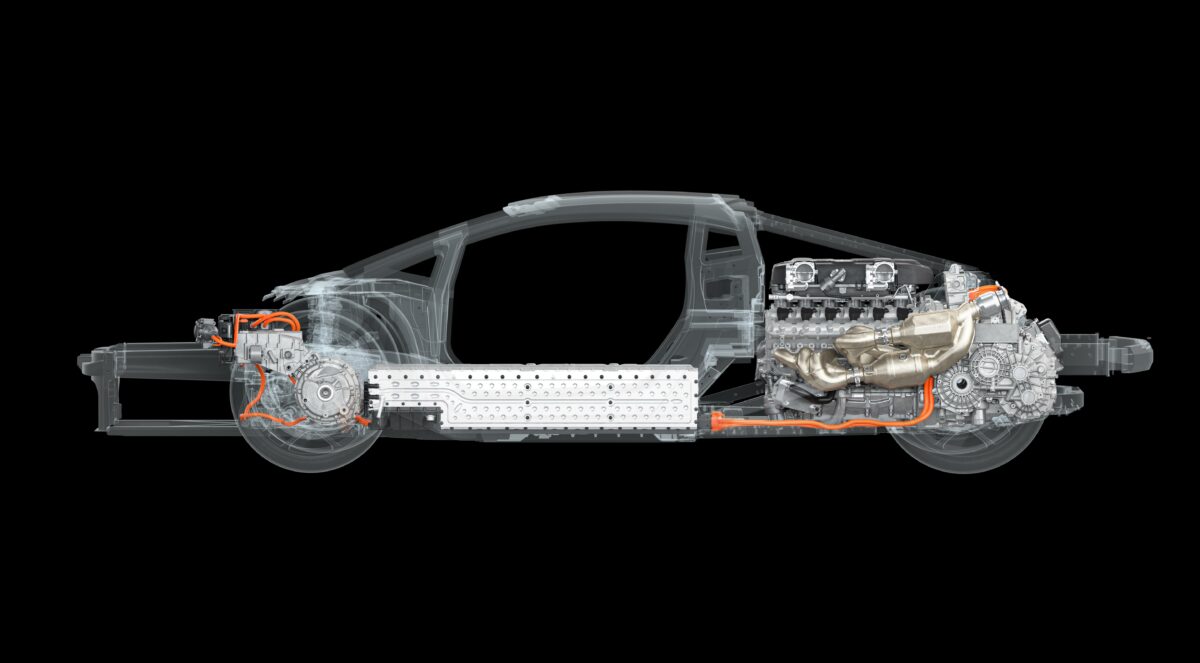Lamborghini, the world-renowned Italian sports car manufacturer, has recently unveiled the details of their first hybrid sports car. It depicts the bold step of the company towards electrification. Internally codenamed LB744, the new hybrid sports car will deliver an exhilarated driving experience. Lamborghini has slated the debut of the new PHEV sports car on the auspicious 60th-anniversary occasion. Lamborghini is geared up to set the benchmark of performance and exhilarating driving experience with the new LB744.
The Powertrain Infrastructure
At the heart of the LB744 lies a unique powertrain, representing a first for the manufacturer. Combining electric assistance with a 12-cylinder block, the L545 engine boasts an impressive 6.5 liters of displacement and a weight of just 218kg – 17kg lighter than the Aventador’s engine. With an output of 825ps at 9250rpm and 725Nm of torque at 6750rpm, this new Superquadro V12 motor sets a new standard for power and performance. The engine revs all the way up to 9500rpm, delivering a power per liter ratio of 128ps/L – the highest in the brand’s history. With a combined power output of 1000ps, the LB744 promises to be a true powerhouse on the road. To ensure maximum performance, the air ducts have been expertly tweaked to increase airflow into the combustion chamber, while the engine’s high compression ratio of 11.8:1 ensures optimal efficiency and performance.

Lamborghini’s Unique Drivetrain
The new Lamborghini LB744 features a unique layout of its powertrain. In this powertrain, the engine power is supplied to the rear wheels and the electric power is channeled to the front wheels. It has optimum final drive ratios in order to provide a phenomenal driving experience. An additional electric motor is plonked in near the transmission setup which further supplies the power to the rear wheels depending on the conditions. The electric motors generate the power from a 3.8kwh Lithium-ion battery. With the new setup of the powertrain, the brand has retained one of the strongest legacies of channeling the power to the wheels via a 4-wheel drive system.
This powertrain is capable of handling up to 1000ps of power without any trouble. In addition, the powertrain also features torque vectoring technology which ensures optimum torque delivery to all the wheels depending on the conditions. The torque vectoring enhances the driving dynamics and minimizes the energy losses during braking with recuperation. In EV mode, the power is channeled to the front wheels only for energy optimization. However, the electric power can be delivered to the rear wheels on demand.
Zero-emission Performance
The manufacturer has slammed in a highly specific 3.8kWh lithium-ion battery pack within the central tunnel ensuring a low center of gravity and optimum weight distribution. The lower layer ensures the protection of the battery. Furthermore, the battery is connected to the integrated charging unit and electric motors at the front as well as the rear. This battery can be charged by using a conventional AC charger in 30 mins. or by regenerative braking from the front wheels or directly from the engine in 6 mins.
About the New Transmission
Lamborghini has placed the new 8-speed dual-clutch transmission in a transverse manner coupled to the longitudinally placed V12 engine. This ensures an optimum space for accommodating the Li-ion battery packs feeding the electric motors. It depicts the new cutting-edge automotive engineering marvel by the Italian carmaker in the world. With this layout, the brand claims that it offers tremendous weight distribution and optimum wheelbase. This is another car from the Lamborghini lineup after Miura has a transverse laid-out gearbox setup. Unlike the 3 shafts, the new transmission has only 2 shafts for saving space. The electric motor above the gearbox can double up as the starter and generator, capable of delivering power to the front wheels. In the P3 position, the motor separates from the gearbox and belts out the power to combine with engine power delivery. Also, in P3 mode, the electric power can be channeled to the rear wheels depending on the condition. In the P2 position, the motor serves to recharge the battery at low speeds and a starter motor when parked. During reversing, the car runs on a front-wheel drive with electric power. However, if the grip is low, then this car can run on a 4-wheel drive even during reversing.
